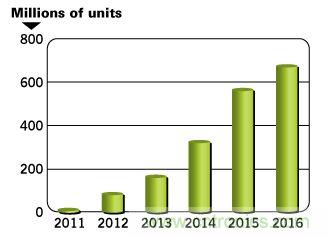【导读】据IHS iSuppli预测,到2016年,应用于智能手机的MEMS压力传感器出货量将上升至6.81亿,比起2012年的82亿将增长8倍。MEMS压力传感器今年的出货量预计会翻一番,将达到1.62亿,主要是由于三星Galaxy S4及其它智能手机的采用。
随着Galaxy S4的问世,三星将继续主导采用了压力传感器的智能手机市场,为这一器件未来几年的大规模增长铺平了道路。
据IHS iSuppli预测,到2016年,应用于智能手机的MEMS压力传感器出货量将上升至6.81亿,比起2012年的82亿将增长8倍。如下图所示,MEMS压力传感器今年的出货量预计会翻一番,将达到1.62亿,主要是由于三星Galaxy S4及其它智能手机的采用。

MEMS出货量增长预测
“Samsung is the only major original equipment manufacturer (OEM) now using pressure sensors in all its flagship smartphone models,” said Jérémie Bouchaud, director and senior principal analyst for MEMS and sensors at IHS. “The company appears to be slightly ahead of its time in its adoption of pressure sensors, even though the most compelling application—indoor navigation—is still not ready for deployment. However, Samsung seems to want to anticipate the start of this market and get a jump on the competition for pressure sensors. The pressure device represents just one component among a wealth of different sensors used in the S4.”
Pressure’s rising
Besides Samsung, few other OEMs have been using pressure sensors in smartphones. The only other smartphone OEMs to use pressure sensors in their products are Sony Mobile in a couple of models in 2012, and a few Chinese vendors, like Xiaomi.
Apple Inc., which pioneered the use of MEMS sensors in smartphones, does not employ pressure sensors at the moment in the iPhone. However, IHS expects Apple will start them in 2014, which will contribute to another doubling of the market in 2014 to 325 million units.
Applying pressure
Although pressure sensors aren’t very useful currently in smartphones, they hold strong potential for the future.
The most interesting application now is the fast Global Positioning System (GPS) lock, wherein the GPS chipset can lock on to a satellite signal and calculate positions more quickly by using the pressure sensor to determine the smartphone’s altitude.
However, the most exciting use for pressure sensors in the future will be indoor navigation, an area with massive potential growth in retail and travel applications. Pressure sensors will provide the floor accuracy required to determine which level a user is on within a structure.
While the ecosystem is not yet fully in place for indoor location/navigation, IHS anticipates this market will reach a breakthrough in growth during the next 12 to 18 months.
By this time, Samsung will have a considerable lead over Apple and other competitors in the installed base of pressure sensors in smartphones.
Samsung takes lead in smartphone MEMS sensors
Although Apple pioneered the usage of MEMS sensors in smartphones, and was the top consumer of these devices for many years, Samsung in 2012 took the lead from Apple for the first time. With Samsung expected to maintain hegemony in smartphone shipments in 2013 and the company loading up on the number of MEMS and other sensors in each smartphone that it ships, its lead in this area is is likely to continue to grow.
Given its emphasis on detecting and adapting to consumer lifestyles, the Galaxy S4 integrates a wealth of different sensors, including the accelerometer, RGB light, geomagnetic, proximity, gyroscope, barometer, gesture and even temperature and humidity varieties.
Sensor suppliers
While IHS has not yet conducted a physical teardown of the Galaxy S4, the IHS iSuppli MEMS and Sensors Service is able to anticipate the likely suppliers of these devices for the smartphone.
The pressure sensor in the S4 is made either by STMicroelectronics, as it was in the Galaxy S III; or by Bosch, like what was used in the Galaxy Note 1 and 2. Both companies are the only mass producers of these devices today for handsets.
And just as in the Samsung Galaxy S III, STMicroelectronics and yet another supplier, InvenSense, are expected to share the supply of the S4’s inertial measurement unit (IMU), which combines the accelerometer and gyroscope.
Meanwhile, the S4’s compass could be supplied by any one of three entities: by AKM—the same as the Galaxy S III; or by Yamaha—as was used in a previous member of the Galaxy smartphone line; or by Alps—which is an up-and-coming manufacturer in this area.
Maximum RGB
IHS expects that Samsung will continue to use an RGB sensor in the S4, as part of a combo device that aggregates RGB, proximity, and IR LED emitter, as it did in the Galaxy Note 2 and the Samsung S III. Samsung was the only user of such combo sensors in smartphones in 2012.
If the RGB sensor is installed on the side of the S4 display, it will be used to sense the color temperature of the room where it’s located, and adapt the contrast and colors on the display to enhance the viewing experience. Such RGB sensors are useful for high-end displays. Since the Galaxy S4 is expected to have full high-definition display—unlike the S3—the added value of having an RGB sensor might be more obvious and noticeable in the S4.
The RGB sensor also could be installed on the back the Galaxy S4 in conjunction with the camera module. This can help in taking better pictures by correcting the white balance.
Capella Microsystems is likely to be the RGB supplier, just as in the Galaxy S III. Other potential suppliers are ams-TAOS, Maxim and Hamamatsu.




